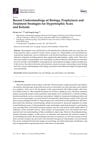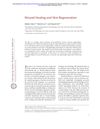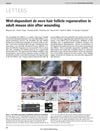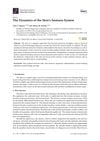TLDR Gamma-irradiated amniotic fluid improves healing and reduces thickness of hypertrophic scars.
The study demonstrates that pooled, frozen, gamma-irradiated human amniotic fluid (PFI-hAF) significantly enhances the healing of hypertrophic scars in a rat model. PFI-hAF accelerates the remodeling process, leading to reduced fibrosis, improved tissue organization, and increased hair follicle density compared to control groups. It promotes reepithelialization, enhances M2 macrophage activity, and improves collagen organization, resulting in more organized collagen structures and reduced scar width. These findings suggest that PFI-hAF is a promising, minimally manipulated treatment for wound care, offering practical advantages such as room-temperature stability and reduced risk of contamination, with potential applications in regenerative medicine.
 305 citations
,
March 2018 in “International journal of molecular sciences”
305 citations
,
March 2018 in “International journal of molecular sciences” The document concludes that the understanding of scar formation is incomplete and current prevention and treatment for hypertrophic scars and keloids are not fully effective.
 359 citations
,
January 2015 in “Cold Spring Harbor Perspectives in Medicine”
359 citations
,
January 2015 in “Cold Spring Harbor Perspectives in Medicine” Hair growth phase and certain genes can speed up wound healing, while an inflammatory mediator can slow down new hair growth after a wound. Understanding these factors can improve tissue regeneration during wound healing.
 829 citations
,
May 2007 in “Nature”
829 citations
,
May 2007 in “Nature” Hair follicles can regrow in wounded adult mouse skin using a process like embryo development.
 306 citations
,
April 2019 in “International Journal of Molecular Sciences”
306 citations
,
April 2019 in “International Journal of Molecular Sciences” The skin has a complex immune system that is essential for protection and healing, requiring more research for better wound treatment.
1 citations
,
March 2023 in “Pharmaceutics” PBMCsec can help reduce and improve thick skin scars.

Wound healing is complex and requires more research to enhance treatment methods.
 December 2023 in “Regenerative therapy”
December 2023 in “Regenerative therapy” miRNA-based therapies show promise for treating skin diseases, including hair loss, in animals.
 July 2024 in “Periodontology 2000”
July 2024 in “Periodontology 2000” Autologous platelet concentrates show promise in esthetic treatments but need more standardized research.








